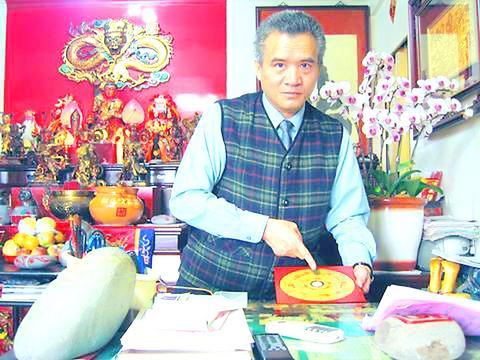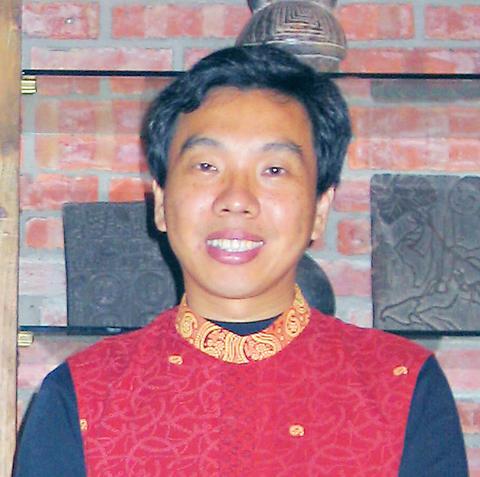No one would believe that behind the ceramic tile exterior of Chen Hsuan-yi's (陳軒翊) Shulin apartment lies an office that makes one want to work overtime. The scent of teakwood from the carved door frames, the gentle breeze from ceiling fans and the brick and mahogany-colored walls were all selected by the fengshui master to create a positive working environment.
Fengshui is a booming business, but as interest in the subject increases, so does the number of critics and charlatans looking to cash in on its popularity.

GAVIN PHIPPS, TAIPEI TIMES
Rich in history and subject to complex rules, fengshui, put simply, is the placement of objects and furniture in one's home so as to maximize the flow of energy or qi. Its roots are planted in the I-Ching, or Book of Changes, an ancient Chinese divination manual from some 5,000 ago.

DIANA FREUNDL, TAIPEI TIMES
For experts and masters, fengshui is a complex science that follows calculations using a Chinese compass or luo pan (
"It is much more than moving furniture around. There is internal and external fengshui and if you really want to improve your quality of life, you must pay attention to both parts," Chen said. Internal fengshui involves living a healthy lifestyle -- early to bed, early to rise, and everything in moderation. External fengshui involves the placement of furniture in one's living and working environments. For accurate readings, both require the date of birth and the height and weight of the people involved.
Chang Hsu-chu (
"Many who claim to be experts are not. They realize there is money to be made in this field. After they read a few books to learn the basics, they start to counsel people on how to arrange their homes," he said.
Having studied the art of spatial harmony for more than 20 years, Chang is regarded as one of Taiwan's leading fengshui experts. His biggest projects to date include Taipei 101 and the Presidential Office.
Given the different approaches, there is debate as to who is an authentic practitioner and who is merely jumping on a profitable bandwagon. Chen and Chang's methods are substantially different. Chang can offer advice on how to rearrange furniture over the telephone and can counsel on the basis of a faxed floor plan.
Chen needs to meet with his clients in person to complete a detailed survey before he will give any advice. Chang is fond of using crystals to maximize love, health and wealth, whereas Chen prefers more general recommendations such as adjusting lighting and coloring and most importantly, using plants. Chang is not a fan of plants inside the home.
"Different masters give different readings ... The most important thing is for the person occupying the space to feel comfortable. If you feel at ease, then the energy flow is good, if you feel stressed, there must be something blocking that flow," Chen said.
In addition to teaching fengshui theory, Chen takes on large projects for companies in both Taiwan and China. One point he is sure to get across is the importance of keeping things green. "Fengshui should not hurt the environment. It should always work together with nature," Chen said.
Not everyone agrees, however, that fengshui is in fact in the best interests of nature. Green Formosa Front Chairman, Wu Tong-jye (
"Mountains might be an ideal place for meditation because they have good fengshui, but are the temples the best thing for the mountains?"
When trees are cut down, the soil is eroded which later causes landslides, said Wu, citing the illegal construction of several temples in the Bali and Puli areas.
Family burial areas cause a similar problem, he said. "People believe putting the tomb on the mountain will provide good fengshui and that will help to bring good fortune for the next generations; but preserving a healthy natural environment is also important for future generations."
Wu is not the only one who has found himself at odds with the practice. Professional interior designers do not, strictly speaking, adhere to the principles of fengshui.
"It is not an academic field because it is still considered among scholars to be a sort of superstition. When someone talks about fengshui in an academic setting, they will not be taken seriously," said Tsai Jen-hui (蔡仁惠), a professor of architecture at National Taiwan University of Technology.
More recently, however, students of architecture and design have been studying fengshui to look for ways to join the two fields. At present, Tsai has four graduate students researching the relationship. One of the benefits is to avoid conflict when working with clients. "Almost everyone believes in fengshui, even if only a little. So now we see more and more students who want to learn about it, and how they might apply it to their own work."
While future interior designers and architects prepare to take on the roles of masters and designers, those already working in the field continue to follow their clients, regardless of their own personal convictions.
"We are employed by a client and if the client believes strongly in fengshui then it is important we try to accommodate him," said Peter Young, vice general manager at Steven Leach Group, a Taipei-based architect and interior-design company.
Young said once a master has looked over the building or blueprint, he will pass on his recommendations to the designer, who will take them into consideration. When creative differences arise, the designer will look for a "compromise solution" that fits within the guidelines of design without breaking any major fengshui rules.
"We know enough to always ask straight away what kind of role it will play. The most important thing is to get the experts involved as early as possible to mitigate the impact of any future conflict," explained David Pipkin, the managing director of Steven Leach Group.
The worst case involved a large office project in which the owner's husband was a fengshui student. "He was very insistent that the front entrance should be in the center. This would have made the public area almost three quarters of the entire office space. It was an impossible expectation and, in the end, the owner realized it as well."
In most cases the recommendations are common sense, not putting your back to the door or sitting at the end of the corridor. It's not practical and it doesn't look good, Pipkin explained. "But that's not to say there aren't times when issues of conflict arise," he added.
After more than 30 years of operation and eight branches across Asia, Pipkin said the best advice came from the company founder who would say, "We've been here too long not to believe in it."
Room chart
DIY Fengshui: The following guide is based on interviews with two fengshui masters in Taiwan, in addition to book, magazine and internet searches.
The Nine Bagua Areas: (Align the ''career square'' with the front entrance to your home or just one room. Suggested items and colors to be used in these areas.
■ Northeast: Wisdom
Color: Blue, green or black
Object: Books (keep this area organized)
■ East: Health and Family
Color: Blue or green
Object: Plants, flowers
■ Southeast: Wealth
Color: blue, red or purple
Object: wind chimes
■ North: Career
Color: Black, blue or brown
Object: Water fountain or painting of water
■ Center: Center for energy
Color: Yellow or earth tones
Object: Nothing, best for meditating, sitting
■ South: Fame and reputation
Color: Red
Object: Candles (think fire not water)
■ Northwest: Influential people
Color: White, gray or black
Object: Something you would lend to a friend ■ West: Creativity Color: White or pastels Object: Artwork, homemade crafts ■ Southwest: Love and Marriage Color: Pink or white Object: Matching items (no photos or mirrors)For your information
Name: Chen Hsuan-yi (For your information
Name: Chang Hsu-chu (

June 9 to June 15 A photo of two men riding trendy high-wheel Penny-Farthing bicycles past a Qing Dynasty gate aptly captures the essence of Taipei in 1897 — a newly colonized city on the cusp of great change. The Japanese began making significant modifications to the cityscape in 1899, tearing down Qing-era structures, widening boulevards and installing Western-style infrastructure and buildings. The photographer, Minosuke Imamura, only spent a year in Taiwan as a cartographer for the governor-general’s office, but he left behind a treasure trove of 130 images showing life at the onset of Japanese rule, spanning July 1897 to

One of the most important gripes that Taiwanese have about the Democratic Progressive Party (DPP) is that it has failed to deliver concretely on higher wages, housing prices and other bread-and-butter issues. The parallel complaint is that the DPP cares only about glamor issues, such as removing markers of Chinese Nationalist Party (KMT) colonialism by renaming them, or what the KMT codes as “de-Sinification.” Once again, as a critical election looms, the DPP is presenting evidence for that charge. The KMT was quick to jump on the recent proposal of the Ministry of the Interior (MOI) to rename roads that symbolize

On the evening of June 1, Control Yuan Secretary-General Lee Chun-yi (李俊俋) apologized and resigned in disgrace. His crime was instructing his driver to use a Control Yuan vehicle to transport his dog to a pet grooming salon. The Control Yuan is the government branch that investigates, audits and impeaches government officials for, among other things, misuse of government funds, so his misuse of a government vehicle was highly inappropriate. If this story were told to anyone living in the golden era of swaggering gangsters, flashy nouveau riche businessmen, and corrupt “black gold” politics of the 1980s and 1990s, they would have laughed.

In an interview posted online by United Daily News (UDN) on May 26, current Chinese Nationalist Party (KMT) Chairman Eric Chu (朱立倫) was asked about Taichung Mayor Lu Shiow-yen (盧秀燕) replacing him as party chair. Though not yet officially running, by the customs of Taiwan politics, Lu has been signalling she is both running for party chair and to be the party’s 2028 presidential candidate. She told an international media outlet that she was considering a run. She also gave a speech in Keelung on national priorities and foreign affairs. For details, see the May 23 edition of this column,